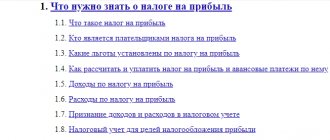Object of taxation
Based on accounting theory, the object is the base that is taxed, and the subject of taxation is the one who pays. From the name of the tax it is clear that the object refers to profit. But the profit is not all, but very accurately calculated in accordance with the rules of the Tax Code. This is the main element of income tax.
Tax payers are both domestic and foreign companies, of course, with some exceptions. For Russian companies, profit means the amount of income minus costs.
If we are talking about a foreign organization, then income received on the territory of our country is taken.
As a general rule, economic benefits are recognized as income, provided that three rules are observed:
- It is received in cash or other property;
- It can be assessed;
- It is determined according to the rules of Chapter 25 of the Tax Code of the Russian Federation.
But this is the so-called net profit; for tax purposes it must be reduced by expenses.
Income, as well as expenses, are divided into those that are taken into account when calculating taxes and those that are not taken into account. The latter, in turn, are divided into income from sales and from non-operating activities.
The income will not include the amount of taxes that the company will present to its customers, for example, VAT.
The amount of income and expenses can be taken into account and determined only on the basis of documents, including primary, tax documents, which include: contracts, invoices, bills, acts, reports, etc.
We decipher the concept of “income tax”
Under this name lies a type of tax that is levied directly on the profits of an enterprise or organization. Let us dwell in more detail on what is considered the profit of an enterprise.
As you might guess, profit is the direct difference between financial receipts and expenses (i.e., income and expenses).
- Income is those proceeds that are generated as a result of the sale of goods and provision of services, that is, from the main activities of the company. In addition, funds from additional services , such as interest on deposits, rental of company property and some others, are considered income. When calculating income tax, there is no need to take into account excise taxes and VAT.
- Expenses are considered to be all costs of internal and external enterprises, motivated and documented. Paying staff, upgrading equipment, purchasing raw materials are the main expenses. Non-operating or non-core expenses are, for example, arbitration or court fees, exchange rate differences, etc.
There is another type of expense, which is less common, the so-called closed one - replenishment of the authorized capital, payment of loans, calculation of dividends. These expenses are not taken into account when calculating income taxes.
Thus, the tax base is considered to be taxable cash income. In cases where, based on the results of the main annual tax period, expenses exceed income, the tax base becomes zero.
Attention! During on-site audits, tax officials most often focus on the company’s expenses. There are often quibbles on their part due to incorrect justification of expenses by the accounting department, violations in terms of documentation, and the like.
The tax base
The element of income tax that is formed as a result of the excess of income over expenses is the tax base. If a company has no income, but has a loss, then the tax base is zero. Profit is calculated on an accrual basis from the beginning of each calendar year.
In order to avoid problems with the tax authorities, it is necessary to accurately determine the tax base from which the tax to be transferred is obtained, that is, to accurately determine which amounts relate to taxable income, and which amounts can be taken into account in expenses in strict accordance with the Tax Code of the Russian Federation.
There are a number of rules for determining the tax base:
- If the tax rate is one, then the tax base is also one. If there are activities taxed at different rates (for example, dividends from Russian and foreign organizations), then the tax base for such income is formed separately.
- There are transactions for which a special procedure for accounting for profit and loss is established. Profit from such transactions increases the organization’s income, and losses are recognized in a special manner. They must be accounted for separately. Such operations include: activities for trust management of property, participation in a simple partnership agreement, etc.
- Income and expenses from activities that are not subject to income tax are also taken out of the equation and separate accounting must be kept for them. Such activities, in particular, include the gambling business, special regimes are applied, etc.
The tax base is calculated based on the calculation. It is a document in free form with analytical accounting information. It reflects information about the financial result from the sale, while separately recording data on the sale of self-produced services, other property, securities, fixed assets, etc. Activities related to the special taxation procedure in accordance with the Tax Code are taken into account separately. The calculation also indicates income from non-operating activities. Separate accounting is maintained for transactions with financial instruments of futures transactions.
To calculate the tax base for the reporting period, profit (loss) from sales is summed up with profit (loss) from non-operating activities. If the result is a loss, then the tax base is zero; if there is a profit, then we can reduce it by losses from previous periods. The remaining amount is the basis for calculating income tax and is multiplied when applying the regular rate by 20%. After calculating the tax, a tax return is completed.
Taxable period
There are concepts of tax period and reporting period. The element of income tax - the tax period, when it comes to income tax, is understood as a calendar year. During the year, the tax base is created and the exact amount of tax payable arises. And in the reporting period, subtotals are generated and advance payments are made.
For newly created organizations, the tax period begins from the day of registration until the end of the year. And if the company was created in December, then the “year” for such newcomers will be counted from the date of registration until the end of the next calendar year.
If a company is liquidated or reorganized, the tax period is considered to be the period from the beginning of the year until the day of termination of activities.
The reporting period can be quarterly (1 quarter, half a year, 9 months) and monthly.
Who is the subject of income tax?
As the law states, taxpayers for this tax levy are all legal entities registered in Russia - LLC, CJSC, etc., as well as individual entrepreneurs. Foreign organizations operating in our country are also required to pay income tax.
Exceptions! The management of the enterprise should keep in mind that in some cases, income tax should not be charged. For example, if a company switched to the Unified Tax Code, the simplified tax system, as well as those types of activities that fall under UTII.
Tax rate
This is another element of income tax. The tax rate is fixed in the Tax Code and is generally 20%, but there are exceptions that are specified in the code. The tax is transferred in the amount of 2% to the federal budget and 18% to the regional budget in separate payment orders.
The Tax Code also provided for separate tax rates for certain categories of taxpayers. For example, the income of foreign companies is taxed at a rate of 20% to the federal budget.
Subjects of the Russian Federation can introduce reduced rates for their taxpayers, but not less than 13.5%. There are other restrictions on rates, for example, for residents of a special economic zone, the tax rate payable to the regional budget cannot be higher than 13.5%.
Tax calculation procedure
This element of income tax depends on the size of the company's income. If the company's revenue is less than 60 million rubles. for the four previous quarters, then payments are made quarterly. If the organization has more income, then you can pay monthly during the quarter and quarterly advances or advance payments every month based on actual profits.
Only quarterly payments are made by budgetary institutions (with the exception of theaters, museums, concert venues), representative offices of foreign companies, non-profit organizations (without profit from the sale of work, services), participants in simple partnerships, beneficiaries under trust management agreements.
To calculate the quarterly payment, the tax base is taken on an accrual basis from the beginning of the year to the end of the reporting period and multiplied by a rate of 20%. The tax is also calculated separately for budgets. The amounts received are recorded in the tax return.
But to obtain the amount payable, you need to subtract from the quarterly payment received for this reporting period the amounts of payments that were paid for previous reporting periods in this tax period.
If there are monthly payments in addition to quarterly payments, they are calculated as follows:
In the 1st quarter of 2022:
Advance for 4 quarters 2016 / 3
In fact, the payment will be equal to payments for Q4. previous year.
In the 2nd quarter of 2022. The advance payment is calculated based on the results of the first quarter and 1/3 of the amount received is paid monthly:
Advance for 1 sq. 2016 / 3
In the 3rd quarter of 2022:
Advance for 2 quarters 2022 – Advance for 1 sq. 2022 / 3
In the 4th quarter of 2022:
Advance for 9 months. – Advance for 2 quarters/3
Monthly payments based on actual profits are calculated similarly to quarterly advance payments, that is, the amount of previously paid payments is subtracted from the calculated amount for the reporting period (tax base on an accrual basis of 20%).
Scheme for calculating and paying income tax
The procedure for paying this type of tax is regulated by Articles 286 and 287 of the Tax Code of the Russian Federation. Article 288 of the Tax Code determines how organizations with separate divisions should pay this tax.
The accounting department of the enterprise must calculate advance payments based on the results of the reporting period and the amount of tax at the end of the tax period. Exceptions are the cases prescribed in Article 286 of the Tax Code of the Russian Federation, when this work is carried out by a tax agent.
Each company develops a schedule for paying advance payments based on actual profits independently, and then fixes it for the coming tax period in its accounting policies.
Procedure and deadlines for tax payment
Depending on how income tax is paid, the following deadlines exist:
- Monthly payments based on actual profits are paid no later than the 28th day of the following month following the reporting month, that is, the tax for September must be transferred before October 28th.
- We pay quarterly payments until April 28, July 28 and October 28 of this year and until March 28 of the next year, the same period for submitting reports.
If the last day falls on a weekend or holiday, then, as a general rule, the deadline is postponed to the next working day. But in any case, you must pay for the year no later than March 28 of the next year. Reports must be submitted within the same period. That is, you must fully report for 2016 by March 28, 2017.
In case of untimely transfer of advance payments, penalties are calculated for each day of delay.
However, fines under Article 122 of the Tax Code of the Russian Federation cannot be applied, since it is impossible to hold people accountable for failure to pay advance payments. You can find more complete information on the topic in ConsultantPlus. Free trial access to the system for 2 days.
Basic elements of taxation
Art. 17 of the Tax Code of the Russian Federation, within the framework of the issue discussed in this article, contains the following concepts:
- Object of taxation (Article 38 of the Tax Code of the Russian Federation).
- Tax base (Article 53 of the Tax Code of the Russian Federation).
- Tax rate (Article 53 of the Tax Code of the Russian Federation).
- Tax period (Article 55 of the Tax Code of the Russian Federation).
- Calculation procedure (Article 52 of the Tax Code of the Russian Federation).
- Procedure and terms of payment (Articles 57, 58 of the Tax Code of the Russian Federation).
These are elements of taxation that are inherent in every tax. Depending on the type of tax, the meanings of one or another element of taxation are different. If at least one of the elements is missing, it is impossible to calculate and pay the tax.






